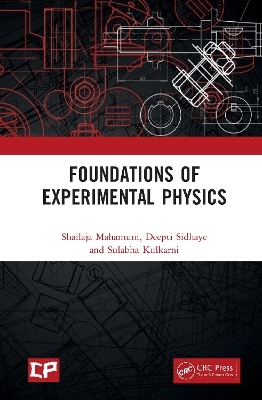
Foundations of Experimental Physics
Seiten
2020
CRC Press (Verlag)
978-0-367-81996-5 (ISBN)
CRC Press (Verlag)
978-0-367-81996-5 (ISBN)
This book addresses a wide scope of the topics in Experimental Physics. Such as, improving signal-to-noise ratio, cryogenic methods, vacuum science, sources and detectors for electrons, photons, error analysis, etc.
Please note: Taylor & Francis does not sell or distribute the Hardback in South Asia.
All solids are composed of atoms or molecules and in order to explain their behavior, experiments and theories came forward. Simultaneously, many new materials were synthetically and systematically developed in the laboratories, properties of which needed to be understood before deploying them in various technologies. It is known that there is a strong correlation between structure and properties of materials. Therefore, experiments on solids involve understanding their structure with diffraction techniques using X-rays, electrons or neutrons. The materials may be in different forms like bulk solid, thin films or powders and need to be observed using microscopes. Finally the properties can be correlated to electronic structure which can be deciphered through various spectroscopy techniques. Magnetic measurements give the insight in to electron-electron correlation. The advantages and limitations of the techniques are also spelled out. In other words, this book takes into account the unaddressed needs of students and teachers associated with the experimental methods. Its relevance has increased manifold, as it addresses a wide scope of the topics in concise manner. Such as‚ improving signal-to-noise ratio, cryogenic methods, vacuum science, sources and detectors for electrons, photons (from infra-red to gamma rays), error analysis, statistical handling of data, etc.
Please note: This title is co-published with Capital Publishers, New Delhi. Taylor & Francis does not sell or distribute the Hardback in India, Pakistan, Nepal, Bhutan, Bangladesh and Sri Lanka.
Please note: Taylor & Francis does not sell or distribute the Hardback in South Asia.
All solids are composed of atoms or molecules and in order to explain their behavior, experiments and theories came forward. Simultaneously, many new materials were synthetically and systematically developed in the laboratories, properties of which needed to be understood before deploying them in various technologies. It is known that there is a strong correlation between structure and properties of materials. Therefore, experiments on solids involve understanding their structure with diffraction techniques using X-rays, electrons or neutrons. The materials may be in different forms like bulk solid, thin films or powders and need to be observed using microscopes. Finally the properties can be correlated to electronic structure which can be deciphered through various spectroscopy techniques. Magnetic measurements give the insight in to electron-electron correlation. The advantages and limitations of the techniques are also spelled out. In other words, this book takes into account the unaddressed needs of students and teachers associated with the experimental methods. Its relevance has increased manifold, as it addresses a wide scope of the topics in concise manner. Such as‚ improving signal-to-noise ratio, cryogenic methods, vacuum science, sources and detectors for electrons, photons (from infra-red to gamma rays), error analysis, statistical handling of data, etc.
Please note: This title is co-published with Capital Publishers, New Delhi. Taylor & Francis does not sell or distribute the Hardback in India, Pakistan, Nepal, Bhutan, Bangladesh and Sri Lanka.
Shailaja Mahamuni, Adjunct Professor, S. P. Pune University, Pune, India Deepti Sidhaye, Assistant Professor, Department of Physics S. P. Pune University, Pune, India Sulabha Kulkarni, INSA Senior Scientist, Centre for Materials for Electronics Technology (CMET). Pune, India
1. Introduction 2. Improving Signal-to-Noise Ratio 3. Vacuum Science and Technology 4. Photons and Electrons: Sources, Monochromators and Detectors 5. Nuclear Accelerators and Detectors 6. Diffraction Methods 7. Microscopy 8. Electron and Optical Spectroscopy 9. Magnetic Spectroscopy, Nuclear Spectroscopy and Magnetisation Measurements 10. Cryogenic Temperature Methods 11. Error Analysis and Statistical Methods
| Erscheinungsdatum | 16.10.2020 |
|---|---|
| Zusatzinfo | 16 Tables, black and white; 204 Line drawings, black and white; 204 Illustrations, black and white |
| Verlagsort | London |
| Sprache | englisch |
| Maße | 156 x 234 mm |
| Gewicht | 748 g |
| Themenwelt | Naturwissenschaften ► Biologie |
| Naturwissenschaften ► Physik / Astronomie ► Atom- / Kern- / Molekularphysik | |
| ISBN-10 | 0-367-81996-1 / 0367819961 |
| ISBN-13 | 978-0-367-81996-5 / 9780367819965 |
| Zustand | Neuware |
| Haben Sie eine Frage zum Produkt? |
Mehr entdecken
aus dem Bereich
aus dem Bereich
Buch | Softcover (2024)
Wiley-VCH (Verlag)
59,90 €


